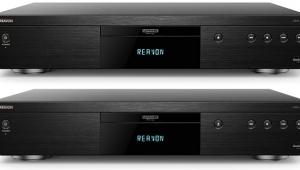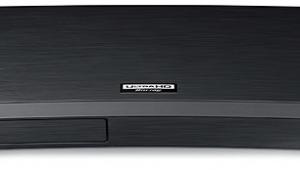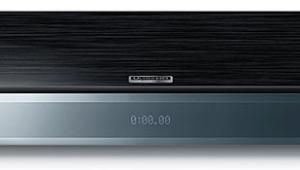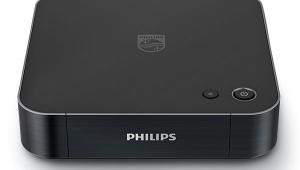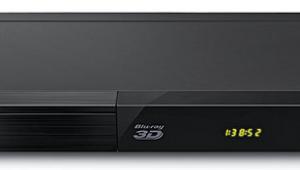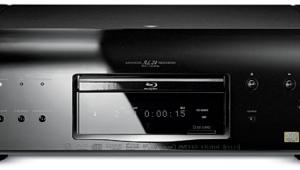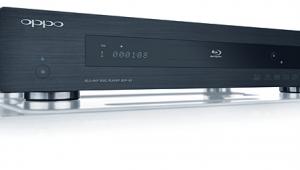Samsung BD-P2500 Blu-ray Player
 Price: $400 At A Glance: Netflix streaming • Average usability • BD-Live support • Outstanding HD and SD video processing by Silicon Optix HQV
Price: $400 At A Glance: Netflix streaming • Average usability • BD-Live support • Outstanding HD and SD video processing by Silicon Optix HQV
Streaming in Blu
Samsung was the first consumer electronics company to bring a Blu-ray player to market. Since then, the company has released quite a few players with varying degrees of performance. With the BD-P2500, Samsung delves into another market for the first time—video on demand. In the January issue, I reviewed the LG BD300, which was the first player to incorporate Netflix streaming capabilities. The BD-P2500 brings this same feature to the fold and includes some other features that the LG lacks.

It’s What’s Inside That Counts
When you look at the BD-P2500, it’s only natural to notice the similarities to the LG’s design. The Samsung’s spec sheet nearly reads the same, and the minimalist design of the front panel only adds to the perception. The BD-P2500’s black faceplate is very unassuming. It features a small Blu-ray logo on the disc tray and a multifunction dial on the right side that serves as the play, skip, and stop controls. A smoked screen covers the digital display. You can dim this during playback, but you can’t turn it off completely.
The back of the unit is pretty standard for a Blu-ray player. The unit features HDMI and component video outputs and a TosLink digital audio output, but it lacks a coaxial digital output. At this price point, it’s also great to find a 7.1-channel analog audio output. This puts the Samsung on the short list of players that will produce lossless audio with older AVRs that lack HDMI inputs.

Since the BD-P2500 is BD-Live compliant, it includes an Ethernet connection and a USB connection. Unlike most BD-Live players we’ve seen, the BD-P2500 has the requisite 1 gigabyte (minimum) of internal data storage built in, so you won’t have to purchase external memory. However, you can use the USB port to expand data storage beyond the 1 GB minimum and for firmware updates. You can also update the player’s firmware via the Ethernet connection if you’re connected to the Internet.
What really sets the BD-P2500 apart from the LG player is the addition of the Silicon Optix Reon video processor with HQV processing. This is one of the premiere designs in video processing, and it’s a rarity in Blu-ray players. The LG player did a decent job with SD video processing and 24p playback of Blu-ray Discs. However, the addition of the Reon in the BD-P2500, makes it a cut above in DVD playback performance and HD video processing for that rare 1080i Blu-ray Disc.
The BD-P2500 offers bitstream output of the lossless audio codecs from Dolby and DTS. The player’s onboard decoding is limited to Dolby TrueHD and Dolby Digital Plus. It will also output uncompressed PCM soundtracks. I’m still surprised to see players ship without full lossless audio decoding, but a DTS-HD Master Audio decoding firmware update is reportedly in the works. The 7.1-channel analog audio output has level and time-alignment controls for each channel, and it has built-in bass management.
Netflix on Demand
The BD-P2500 is the second player we’ve reviewed that features Netflix video streaming. This requires a Netflix rental account (starting at $8.99 per month) and includes unlimited instant viewing via the streaming network. The library of streaming films contains more than 12,000 standard-def titles. However, Netflix doesn’t typically offer new releases on release date, and some time will likely pass before the latest titles become available. But catalog titles are plentiful, and the service even offers TV shows, so you can catch up on your favorites. [During the testing period, only standard-definition Netflix streaming was available. But as we were going to press, Samsung announced Netflix HD streaming was to be enabled via a firmware update available the first week of December. The initial HD offerings from Netflix included more than 300 HD titles at 720p resolution. Look for HT to report on this in a future issue.—SCB]

Setting up the Netflix service is quite simple, and the onscreen menus walk you through the process. Netflix offers a free two-week membership to BD-P2500 owners, so you have the perfect opportunity to see if you’d enjoy this feature with no risk. When you start up the BD-P2500, the Netflix option is right on the home screen for easy access. From there, you simply choose from the films in your queue on the Netflix Website. This is a key distinction: You can’t select the programs you wish to stream from the player’s menus; you must log on to Netflix from a Web browser to manage your queue.
Like the LG player I reviewed, the quality of your Netflix viewing experience depends a lot on your Internet connection speed. I have broadband cable Internet and subscribe to the fastest download rate that my ISP offers. Unfortunately, cable Internet speeds largely depend on how many people are using the pipeline at any one time, so my Internet speed fluctuates throughout the day.
When you start a film, a small quality indicator gives you an idea of what to expect. I saw the quality range from about two bars up to four (four being the highest). With two bars, the quality was pretty bad; it had obvious macroblocking and combing artifacts. It also took longer for films to buffer. With four bars, the quality was close to what we see from DVD playback, depending on the quality of the title. Some movies look better than others, but most big titles looked pretty good. And some titles aren’t 16:9. Some even appear with black bars on all four sides of the screen.
